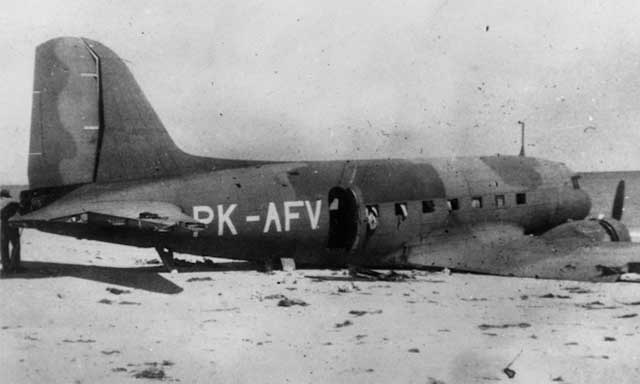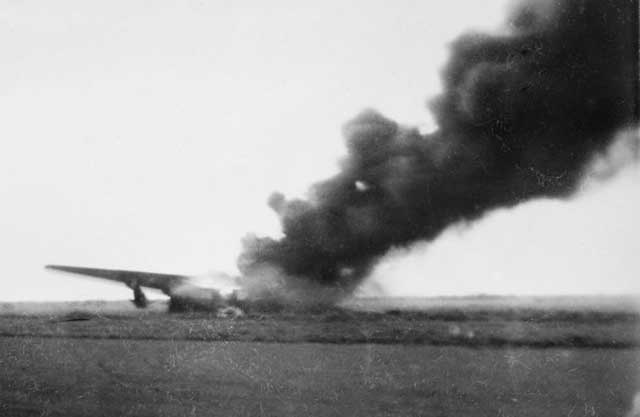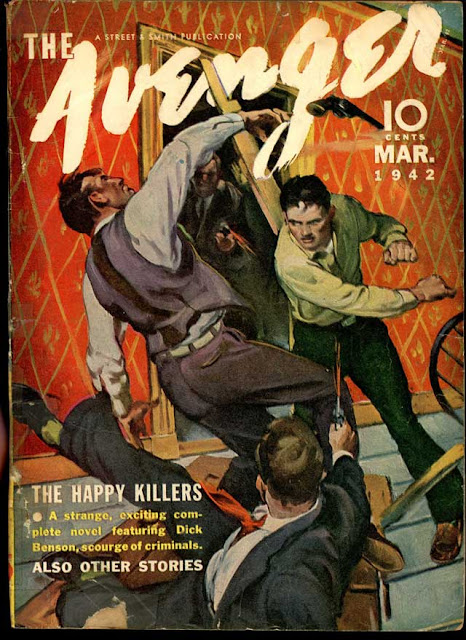Monday 2 March 1942
 |
| Prague citizens inspect a Soviet artillery piece at an exhibit depicting life in the Soviet Union, March 1942. |
Battle of the Pacific: The Japanese Navy scores more successes in the waters around Java on
2 March 1942. It is a dangerous day to be on the water for both sides. The Japanese Navy has complete control of the seas and has stationed ships all around Java to prevent any Allied ships from escaping. Japanese cruisers Takao and Atago find and sink destroyer USS Pillsbury (DD-227) at 21:02. Little is known about this battle because the entire crew perishes, but the Japanese records indicate that it took place west of Christmas Island. Not far away, Japanese heavy cruiser Maya, accompanied by destroyers Arashi and Nowaki, finds destroyer HMS Stronghold (H50) trying to escape from Tjilatjap to Australia and sinks it at 18:58. About 50 survivors ultimately become prisoners of the Japanese.
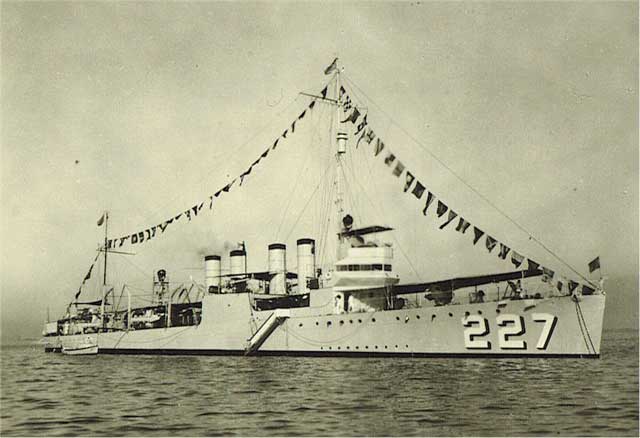 |
| USS Pillsbury, sunk by Japanese cruisers on 2 March 1942. |
Allied shipping losses do not stop there. With the Japanese in complete control of the nearby seas and an invasion in progress, the Allies on Java realize the end is near. They scuttle ships both in the harbor and in drydock at Surabaya (Dutch destroyers HNMS Witte de With and Banckert and US Navy destroyer USS Stewart - the Japanese later raise and use Stewart). Japanese aircraft raid the port and cause further damage to the ships. Japanese forces advance toward Batavia (Jakarta), so the Dutch government leaves for Bandoeng (Bandung) to the southeast. A scratch force of Australian, Dutch, American, and British soldiers under the command of Australian Brigadier Arthur Blackburn ("Blackforce") temporarily blocks the Japanese 16th Army's advance into the city. The Japanese Nasu Detachment (Major-General Yumio Nasu) takes Rangkasbitung and then Leuwiliang, but are stopped there by the Australian 2/2nd Pioneer and 2/3rd Machine Gun Battalions along with artillery fire from the US 2/131st Field Artillery ("D" battery).
 |
| HMS Stronghold, sunk south of Java on 2 March 1942. |
There is a long list of small- to medium-sized Allied ships scuttled, sunk as blockships at various Java ports, or sunk by Japanese naval and air actions. These include:
- 9505-ton Dutch freighter Tjikarang
- 1030-ton Dutch freighter Van Diemen
- 1281-ton Norwegian freighter Tunni
- 7970-ton Dutch freighter Tjikandi
- 1615-ton Canadian freighter Shinyu
- 1799-ton Dutch freighter Sinabang
- 2232-ton Norwegian freighter Prominent
- 322-ton Dutch tanker Milo
- 5400-ton Dutch freighter Koning der Nederlanden
- 340-ton Dutch tanker Kasuaris
- 482-ton Dutch lightship J.H. Menten
- 175-ton Dutch auxiliary minesweeper Endeh (HMV-18, sunk by gunfire south of Java)
- 6924-ton Dutch freighter Bengalen
- 1330-ton Dutch freighter Belawan
- 1053-ton Dutch freighter Benkalis
- 43-ton Dutch tug Dann
- 4323-ton Dutch freighter Liran
- 1865-ton Dutch freighter Loa Koeloe
- 2464-ton Dutch freighter Meroendoeng
- 57-ton Dutch coaster Pehe
- 1793-ton Dutch freighter Silindoeng
- 172-ton Dutch freighter Tamako
- 172-ton Dutch tug Taroena
- 344-ton Dutch tanker Tembusu
- 3545-ton Dutch freighter Sisunthon Nawa
- 620-ton Royal Navy minesweeper HMS Harley
Basically, it is a good day for fish looking for new habitats on the seafloor.
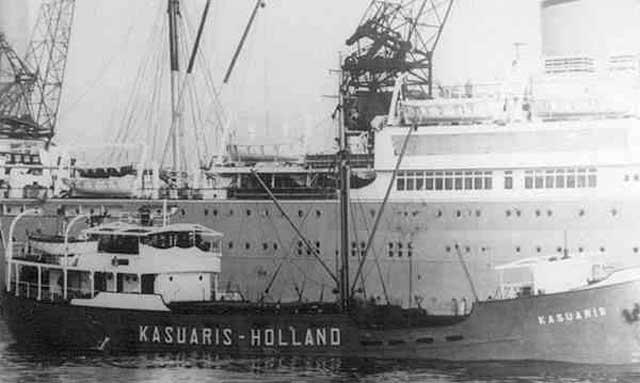 |
| Dutch freighter Kasuaris (in the foreground), scuttled on 2 March 1942. |
Just before midnight, USAAF Fifth Air Force flies its last five B-17s and three LB-30s from Java. They carry 260 men from Jogjakarta Airfield as the Japanese approach. After they leave, the Allies no longer hold any airfield on Java and Headquarters V Bomber Command is dissolves, while Headquarter 19th Bombardment Group transfers from Singosari, Java, to Melbourne, Australia.
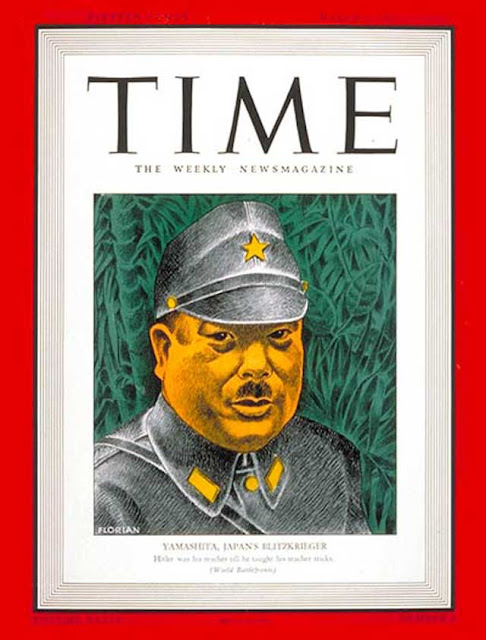 |
| Time magazine, 2 March 1942, features General Yamashita on the cover |
In the Philippines, P-40s based on Bataan attack Japanese shipping in Subic Bay, Luzon, losing four planes (three on crash landings). They sink an auxiliary submarine chaser, 385-ton Kyo Maru No. 11. With supply ships unable to pass through the Japanese blockade, General MacArthur's staff reduces rations to one-quarter of the normal ration. The 95,000 army troops are reduced to hunting any animals they can find in the jungle, and many men come down with diseases such as malaria, diarrhea, and malnutrition. Japanese ships shell US positions on Cebu and Negros Islands, while Japanese troops land on Mindanao Island.
In Burma, Japanese forces continue moving toward Rangoon. While the defending British and Indian forces have established a roadblock on the main road at Pegu with the 17th Indian Division, the Japanese simply leave the roads and bypass them through the jungle.
 |
| The Adelaide, Australia, Advertiser highlights the Japanese invasion of Java in its 2 March 1942 issue. As usual in the media, terrible naval losses are downplayed while supposed victories at sea are trumpeted to make it sound as if everything is going well at sea - when it definitely is not. |
The air war continues in New Guinea, with Japanese air strikes softening up the Huon Gulf area for a planned invasion. The Japanese also have their eyes on Port Moresby, which is difficult to take by land due to mountains that run protect the city from the north. The RAAF sends a Hudson A16-101 on reconnaissance over Rabaul.
US Navy submarine USS Sailfish (SS-192) torpedoes and sinks Japanese aircraft transport Kamogawa Maru north of Lombok Strait. The ship is serving as a troop transport, and 273 troops perish along with 6 sailors (including Captain Shimizu) and 48 passengers.
 |
| German troops ride a captured Soviet KV-2 into Prague for an exhibition of the "real" Soviet Union, March 1942. The tank has the unintended consequence of impressing the local Czechs about the might of the Soviet armed forces. |
Eastern Front: Lieutenant General Dmitry Timofeyevich Kozlov makes one last attempt to break through the Axis line across the Parpach Narrows on the Crimea. He sends two rifle divisions, three tank brigades and a tank battalion to take the German fortified village of Koi-Asan. The Germans have carefully sited their anti-tank artillery, and along with Stukas, they devastate the advancing Soviet tanks, destroying 93 of them (according to Soviet sources). The Red Army makes no worthwhile gains, and Kozlov must admit defeat. However, his forces have gained a small salient in the north of the line which may provide a possible springboard into the interior of the Crimea in future battles. Stalin approves the cessation of the offensive but demands another one within ten days.
At the Fuhrer Headquarters at Rastenburg, Adolf Hitler continues his unexpected leniency on allowing retreats. He approves a plan by General Schmidt of the Second Panzer Army to pull troops back from Belev in order to consolidate his lines. With the spring thaw (Rasputitsa) coming soon, operations are going to die down anyway.
European Air Operations: RAF Bomber Command sends four Boston bombers to attack shipping off Den Helder. All return safely.
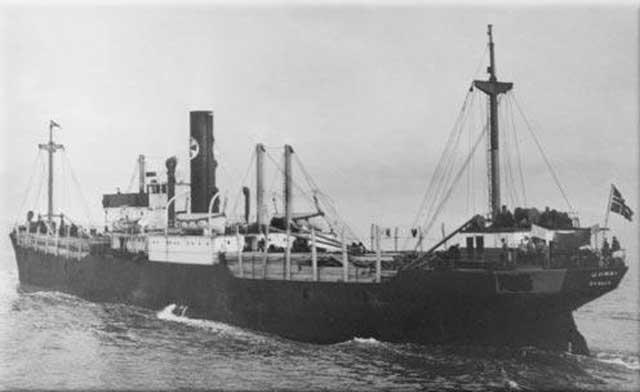 |
| Norwegian freighter Gunny, sunk on 2 March 1942. |
Battle of the Atlantic: U-126 (Kptlt. Ernst Bauer), on its third patrol out of Lorient, torpedoes and sinks 2362-ton Norwegian freighter Gunny about 400 miles south of Bermuda. The ship is hit at 20:47 and sinks within a minute. The crew manages to launch a raft and fourteen men (one later dies) cling to it for a full week before being found by passing Swedish freighter Temnaren.
Battle of the Mediterranean: After dark, the RAF based on Malta sends Wellington bombers based at Luqa Airfield to attack Palermo Harbor, Sicily. This is the usual overnight stopping place for convoys sailing from Naples to Tripoli. The bombers drop 26 tons of bombs, damaging the dockyard area and a seaplane base. The bomber crews also claim to sink two ships of 9000 and 5000 tons and damage a third. The Luftwaffe, in terms, sends Junkers Ju 88 medium bombers to attack numerous places, including Grand Harbor, Lazaretto, Gudja, Safi Strip, Corradino, Cospicua, Zabbar, and Luqa Airfield.
Meanwhile, Royal Navy submarine HMS Turbulent (Cdr. J.W. Linton) has a big day near Thessaloniki, Greece. Commander Linton uses the deck gun to destroy three Greek two-masted schooners. These are 42-ton Chariklia, 250-ton Apostolos, and 45-ton Evangelistria. All three ships are ferrying German troops to their posts on the Aegean islands. The Apostolos' crew manages to beach the ship, but she never sails again. There are two deaths on the Apostolos, including one German soldier.
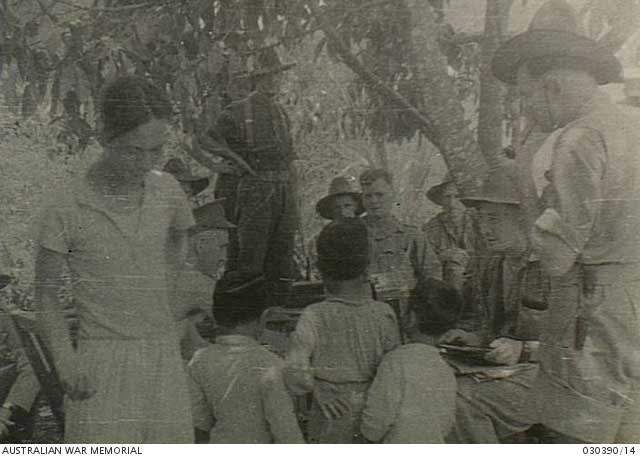 |
| "Tjampea, Java. March 1942. Members of the 2/2nd Australian Pioneer Battalion with young Javanese children in West Java after the action at Leuwiliang and prior to the battalion reaching Bandoeng." Australian War Memorial 030390/14. |
Battle of the Black Sea: Luftwaffe bombers damage 2366-ton Soviet freighter Fabritsius off Novorossiysk in the Caucasus. The captain acts quickly and beaches the ship, but she is ultimately destroyed completely in a friendly fire incident on 12 May 1943.
Australian/Thai Relations: Australia declares war on Thailand.
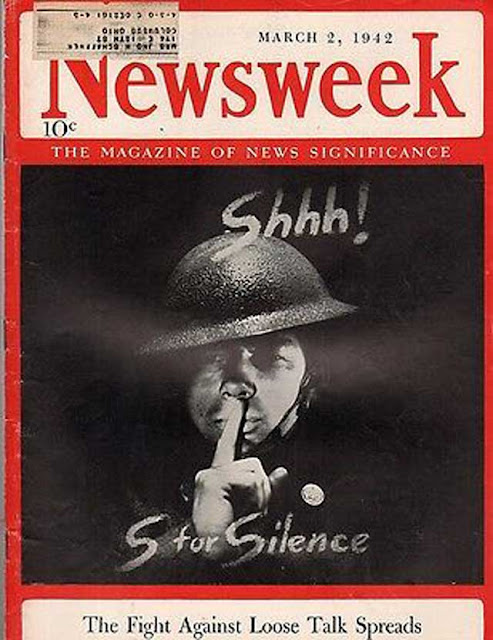 |
| Newsweek magazine, 2 March 1942, embraces the new paranoia about enemy spies. |
US Military: Under Operation Magnet (the transfer of US troops to the British Isles), 8555 US troops arrive at Belfast, Northern Ireland, in a 21-ship convoy (plus escorts). The troops include the headquarters of the 34th Infantry Division and units of the 133d and 168th Infantry Regiments. With these new arrivals, there are 10,433 US Army personnel in Northern Ireland (including 534 officers, 70 nurses, and 2 warrant officers).
The U.S. Naval Air Transport Service begins regularly scheduled operations with an R4D Skytrain flight from NAS Norfolk, Virginia, to NRAB Squantum, Massachusetts.
Headquarters, 19th Bombardment Squadron (Medium), 22nd Bomber Group (Medium), transfers its headquarters from Brisbane to Ipswich, Australia.
 |
| Kamogawa Maru, sunk by USS Sailfish on 2 March 1942. |
Turkey: The Turkish government from now on only allows passage of the Dardanelles by ships under the command of Turkish captains.
Holocaust: German forces liquidate the Minsk Ghetto's nursery/ orphanage. They throw babies and older children into a pit and then bury them alive. According to at least one account, SS officer Wilhelm Kube and other officers throw candy to the shivering children before burying them. When "The Pit" murders are done, about 5000 victims have perished. There is a memorial to the incident at the spot.
 |
| The owner of a grocery store has a huge "I Am An American" sign posted, March 1942. The store, being in Military Area No. 1, is closed after internment begins later in the month and the owner interned (Dorothea Lange (WRA)). |
American Homefront: General John DeWitt, commander of the Western Defense Command, issues Public Proclamation No. 1. This defines the coastal areas of California, Oregon, and Washington, and also part of Arizona, as Military Area No. 1. This new Military Area will define the areas from which persons of Japanese ancestry will be removed to internment camps.
Future History: John Winslow Irving is born in Exeter, New Hampshire. He develops an interest in writing and publishes his first novel, "Setting Free the Bears," in 1968. He continues publishing novels that don't receive much attention until "The World According to Garp" (1978), becomes an international bestseller and is made into a feature film directed by George Roy Hill and starring Robin Williams. After that, Irving enjoys great success and continues publishing novels to great acclaim. As of this writing, Irving continues publishing novels and winning writing prizes.
Lewis Allan Reed is born in New York City, New York. Reed develops a love for music and makes his first recording as a teenager. However, he also begins experiencing panic attacks and other mental issues. This does not stop Reed's musical development, and in 1964 he is signed as a songwriter by Pickwick Records. Living on the Lower East Side, Reed helps to form a new rock band, the Velvet Underground, under the name Lou Reed. This becomes a very influential rock group, though it never experiences that much commercial success. After the band breaks up in 1971, Reed moves back home to Long Island. He soon signs a recording contract with RCA Records and releases his first solo album, "Lou Reed." Reed continues recording and has a big hit, "Walk on the Wild Side." After that, Reed continues releasing material, though it is never as popular. Lou Reed passes away on Long Island on 27 October 2013.
 |
| Ginger Rogers, Academy Award winner in 1941, on the cover of Life magazine, 2 March 1942. |
March 1942March 1, 1942: Second Battle of Java SeaMarch 2, 1942: Huge Allied Shipping Losses at JavaMarch 3, 1942: Japan Raids Western AustraliaMarch 4, 1942: Second Raid On HawaiiMarch 5, 1942: Japan Takes BataviaMarch 6, 1942: Churchill Assaults Free SpeechMarch 7, 1942: British Defeat in BurmaMarch 8, 1942: Rangoon Falls to JapanMarch 9, 1942: Japanese Conquest of Dutch East IndiesMarch 10, 1942:US Navy attacks Japanese Landings at LaeMarch 11, 1942: Warren Buffett's First Stock TradeMarch 12, 1942: Japan Takes JavaMarch 13, 1942: Soviets Attack In Crimea Again March 14, 1942: The US Leans Toward EuropeMarch 15, 1942: Operation Raubtier BeginsMarch 16, 1942: General MacArthur Gets His RideMarch 17, 1942: MacArthur Arrives in AustraliaMarch 18, 1942: Japan Attacks In BurmaMarch 19, 1942: Soviets Encircled on the VolkhovMarch 20, 1942: "I Shall Return," Says MacArthurMarch 21, 1942: Germans Attack Toward DemyanskMarch 22, 1942: Second Battle of SirteMarch 23, 1942: Hitler's Insecurity BuildsMarch 24, 1942: Bataan BombardedMarch 25, 1942: Chinese Under Pressure in BurmaMarch 26, 1942: Win Or Die, Vows MacArthurMarch 27, 1942: The Battle of SuusariMarch 28, 1942: The St. Nazaire Commando RaidMarch 29, 1942: The Free Republic of NiasMarch 30, 1942: Japanese-Americans Off Bainbridge IslandMarch 31, 1942: Japanese Seize Christmas Island2020



